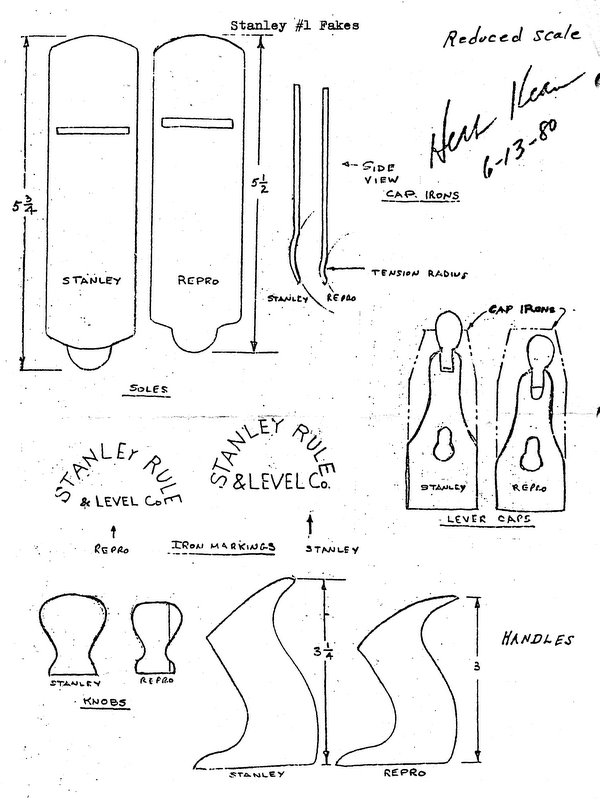
(Webmaster's note: This article was scanned from the October 1988 issue of ToolTalk. No author is credited, although the drawing was clearly done by Herb Kean eight years earlier. According to the issue, it is a modified version of information distributed at an MWTCA meeting. Herb Kean may have been the originator, since his drawing is part of the article.)
If you look at each part of the fake Stanley #1 next to an authentic one, it's hard to believe that anyone would not detect the fake. But, by itself on an auction block, or under the excitement of a bargain, it is possible that the fake could pass, which is exactly what the perpetrator depended on. The defects, errors, and sloppy workmanship involved wore allowed only to the extent that they did severely detract from the overall impression. To this degree the duplicator kept smoothing down the roughly cast parts until they were passable. The fact that they were made considerably undersized by doing this did not bother him. No one thought of measuring, and it wasn’t too likely that they carried Sellens' book at that precise moment anyway.
So today there are a goodly number of these fakes floating around, and possibly more to show up as owners realize what they have purchased. Listed below are the incongruities.
BODY -Overall length to rear of handle extension is only 5 ½"- (approximately ½"short). Also the handle extension is flat with the sole instead of being upraised approximately 1/32".KNOB & HANDLE STUDS - Wrong pitch.
KNOB -Too small, and made of two pieces.
HANDLE - Too short.
KNOB & HANDLE NUTS - Poorly machined with hacksawed slots, wrong pitch. Handle nut - too short (prevents tightening.)
LEVER CAP - Too small all around, and porous. Rivet is brass instead of steel. Lever slot is far too deep.
CAP IRON - Tang hole filed instead of punched. Tension radius is too small and non-functional..
CONNECTING SCREW - Raggedly machined and doesn't fit through mating hole.
PLANE IRON - Stamping out of square, and letters are not all correct size.
FROG - Outline very rough and sanded fully on sides.
FROG SCREWS - Standard round-head instead of Stanley round-head.
FROG WASHERS - Missing.
LEVER CAP SCREW - Standard round-head instead of Stanley oval-head.
ADJUSTMENT KNOB - Heavy porosity. No sign of finishing except with file.
ADJUSTMENT KNOB STUD - Diameter and pitch. wrong.
WEIGHT - 7/8 1b. instead of 1 1/8 1b.
Based upon the markings, the reverse key slot in the plane iron, and the right hand thread in the adjustment knob stud, my guess is it was copied from a true #1 of the 1880 vintage. I feel it was directly cast and smoothed undersize. The "just-get-by" attitude and the "for-profit” motivation rules out the making of patterns. Also, the direct casting (and its resultant shrinkage), would account for a part of the undersize conditions.
Hopefully the information above will help in preventing any further sales of these fakes.
